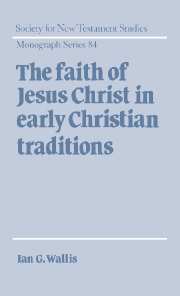Book contents
- Frontmatter
- Contents
- Preface
- Convention for referring to primary and secondary literature
- List of abbreviations
- 1 Setting the scene
- 2 Jesus' faith in the Synoptic Gospels
- 3 Jesus' faith in the Pauline Epistles
- 4 Jesus' faith in the deutero-Pauline and Pastoral Epistles
- 5 Jesus' faith in Hebrews and Revelation
- 6 Jesus' faith in extra-biblical sources
- 7 Concluding remarks
- Select bibliography
- Index of modern authors
- Index of passages
- Index of subjects
3 - Jesus' faith in the Pauline Epistles
Published online by Cambridge University Press: 22 September 2009
- Frontmatter
- Contents
- Preface
- Convention for referring to primary and secondary literature
- List of abbreviations
- 1 Setting the scene
- 2 Jesus' faith in the Synoptic Gospels
- 3 Jesus' faith in the Pauline Epistles
- 4 Jesus' faith in the deutero-Pauline and Pastoral Epistles
- 5 Jesus' faith in Hebrews and Revelation
- 6 Jesus' faith in extra-biblical sources
- 7 Concluding remarks
- Select bibliography
- Index of modern authors
- Index of passages
- Index of subjects
Summary
Preliminary considerations
Over the past two or three decades the question of whether Paul refers to the faith of Jesus Christ has received considerable attention. It constituted the subject matter for the presidential address delivered to the 43rd General Meeting of the Society for New Testament Studies in 1988 and it seems that the question still remains largely unresolved. The debate, which can be traced back with certainty to the previous century, revolves around a number of genitival constructions exhibiting a form of Christ's name qualifying the substantive πίστις:
Romans 3.22 διὰ πίστεως Ἰησοῦ χριστοῦ
Romans 3.26 τὸν ἐκ πίστεως Ἰησοῦ
Galatians 2.16a διὰ πίστεως Ἰησοῦ χριστοῦ
Galatians 2.16b ἐκ πίστεως χριστοῦ
Galatians 2.20 ἐν πίστει ζῶ τῇ τοῦ υἱοῦ τοῦ θεοῦ
Galatians 3.22 ἐκ πίστεως Ἰησοῦ χριστοῦ
Philippians 3.9 τὴν διὰ πίστεως χριστοῦ
The crucial issue is whether one or more of these constructions refers, either exclusively or in conjunction with another party, to the faith of Jesus Christ. Each of these occurrences will be discussed in detail below, but we shall start by introducing the theological issues central to the debate and surveying the pertinent grammatical data. Before doing this, however, it is worth noting that the burden of proof can no longer be thought to rest with those claiming the apostle had Christ's own faith in view.
- Type
- Chapter
- Information
- The Faith of Jesus Christ in Early Christian Traditions , pp. 65 - 127Publisher: Cambridge University PressPrint publication year: 1995

